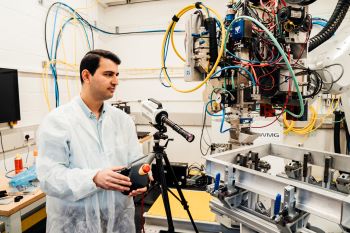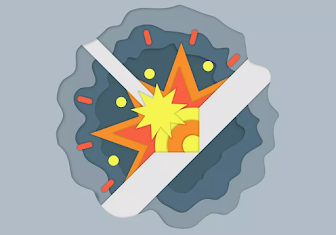Advances in Laser Welding Using Beam Shaping Bolster Green Transport Future
Advances in Laser Welding Using Beam Shaping Bolster Green Transport Future
WMG, in collaboration with Lumentum, a San Jose-based market-leading designer and manufacturer of innovative optical and photonic products, has developed an innovative beam-shaped laser welding technique to dramatically increase the reliability of welded joints between dissimilar metals. In a bid to meet the growing demand for lightweight and environmentally friendly vehicles, this process will allow manufacturers to join mixed materials in an efficient way that does not limit performance.
Challenge
Manufacturers are exploring the use of lightweight and low-cost materials to advance the green transport sector. The use of lighter materials drives energy efficiency gains in transportation products including electric vehicles. Lighter materials include aluminum as well as more novel materials such as recyclable alloys. Until now, progress in using such new materials has been impeded by the challenges involved in joining together metals with dissimilar properties. This is particularly relevant when manufacturing battery packs in electric vehicles, for example, which are home to a range of compositions and elements.
Currently, materials are joined using traditional laser welding processes, which allow for a great amount of precision between like metals. As more innovative and mixed materials are introduced, their varying physical and thermal properties make it challenging to create strong and reliable joints between them with such traditional welding techniques. For example, when a structure made with aluminum is joined to steel and exposed to thermal loads, the two metals expand and contract at different rates, which can result in accumulated stress and failure of the joint.
Solution
In response, WMG collaborated with Lumentum to develop an innovative laser welding solution using novel laser beam shaping approaches for joining different materials. The project focused on the manufacturing of battery packs, where there is huge potential to substantially impact the electric vehicle sector moving forward.
Under a commercial agreement with Lumentum and support from the High Value Manufacturing Catapult, WMG undertook a series of tests and validation work to discover intriguing new relationships between the laser heat input and the material response. The research considered different combinations of dissimilar metals such as aluminum, copper, and steel as well as recycled materials, measuring the success of joints at both a small 10 cm x 10 cm scale and on representative parts, including battery cells and battery enclosures.
The project highlighted significant benefits of laser beam shaping technology over traditional laser welding including creating a larger weld area, reducing weld defects, and improving gap bridging, ultimately resulting in stronger joints. Unlike traditional laser welding, which directs the beam in a single spot, the new beam shaping technology provides the ability to manipulate the way the materials react.

Impacts
The novel laser welding process achieved 70% joint efficiency between steel and aluminum, compared to standard welding’s 20% efficiency (joint efficiency refers to the strength of a welded joint with respect to the strength of the base metal*).
This project has helped to unlock the full potential of laser beam welding as it proved the feasibility of creating stronger joints using beam shaping. This means that better use can be made of materials, optimising product performance and durability, and enabling the adoption of lightweight and environmentally friendly structures in vehicles.
As a result of the work by WMG, Lumentum has been able to validate new laser welding technologies for electric vehicles, opening new business avenues for high-power laser units aided by laser beam shaping.
Bryan Paolini, Technical Programme Manager for beam-shaping at Lumentum, stated:
“The work with Dr Franciosa and his team at WMG provided key insights into how our beam-shaping technology creates advantageous conditions at the work surface and material interfaces. Unique material configurations explored through this collaboration provided information that enabled deeper understanding and pointed to application-specific advancements in the technology”.
Dr Pasquale Franciosa, Reader and Head of the Laser Beam Welding Lab at WMG, commented:
“Laser beam shaping is certainly a game changer in the laser welding industry. Our work with Lumentum has helped to improve our understanding of the material response to axisymmetric beam profiles and ultimately make better use of materials for strategic applications in the e-mobility ecosystem”.
Ends
Click here for more information about Laser Beam Welding research at WMG:Link opens in a new window
Laser Beam Welding at WMG, University of Warwick - YouTube
The research team at WMG have developed a training course for those interested in learning more about the latest laser welding technology and associated services. More information can be found here.Link opens in a new window
To work with WMG, contact wmgbusiness@warwick.ac.uk
*A joint efficiency of 100% means that the joint is able to transfer the full strength of the base material, while a joint efficiency of 50% means that the joint is only able to transfer half of the strength of the base material.
This project has helped to unlock the full potential of laser beam welding as it proved the feasibility of creating stronger joints using beam shaping. This means that better use can be made of materials, optimising product performance and durability, and enabling the adoption of lightweight and environmentally friendly structures in vehicles.
As a result of the work by WMG, Lumentum has been able to validate new laser welding technologies for electric vehicles, opening new business avenues for high-power laser units aided by laser beam shaping.
Bryan Paolini, Technical Programme Manager for beam-shaping at Lumentum, stated:
“The work with Dr Franciosa and his team at WMG provided key insights into how our beam-shaping technology creates advantageous conditions at the work surface and material interfaces. Unique material configurations explored through this collaboration provided information that enabled deeper understanding and pointed to application-specific advancements in the technology”.
Dr Pasquale Franciosa, Reader and Head of the Laser Beam Welding Lab at WMG, commented:
“Laser beam shaping is certainly a game changer in the laser welding industry. Our work with Lumentum has helped to improve our understanding of the material response to axisymmetric beam profiles and ultimately make better use of materials for strategic applications in the e-mobility ecosystem”.
Ends
Click here for more information about Laser Beam Welding research at WMG:Link opens in a new window
Laser Beam Welding at WMG, University of Warwick - YouTube
The research team at WMG have developed a training course for those interested in learning more about the latest laser welding technology and associated services. More information can be found here.Link opens in a new window
To work with WMG, contact wmgbusiness@warwick.ac.uk
*A joint efficiency of 100% means that the joint is able to transfer the full strength of the base material, while a joint efficiency of 50% means that the joint is only able to transfer half of the strength of the base material.
Twitter : https://x-i.me/weltut
Facebook : https://x-i.me/welfb
#ScienceFather#ResearcherAward#LaserWelding,#BeamShaping,#GreenTransport,#SustainableManufacturing,#AdvancedManufacturing,#CleanEnergy,#EcoFriendlyTech,#FutureOfTransport,#Innovation,#TechForGood,#GreenTech

Comments
Post a Comment